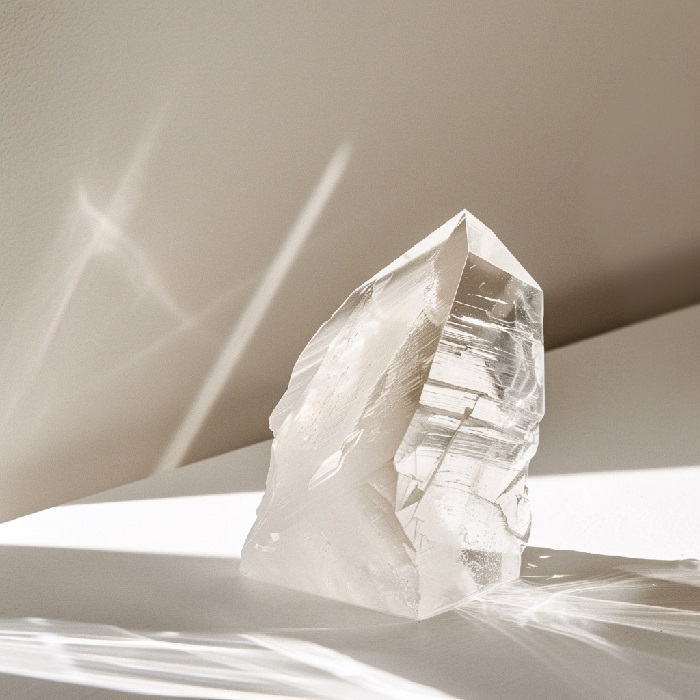Crystal Quartz Mining
CRYSTAL QUARTZ :
Crystal Quartz derives its name from two distinct origins: 'crystal' from the Greek word 'krystallos,' meaning 'ice,' and 'quartz' from the Saxon word 'querklufterz,' meaning 'cross vein ore.' It exists in numerous varieties. Buyers are advised to be well-informed about quartz and its various forms before making a purchase.
WHERE IS IT FORMED?
This appealing beauty is created deep within the Earth's crust during the crystallization of two abundant elements, namely silicon and oxygen. It constitutes approximately 12% of the Earth's crust. A wide variety of igneous, sedimentary, and metamorphic rocks contain this crystal. These large crystals occur worldwide as horizontal hexagonal prisms terminated by a combination of positive and negative rhombohedra, forming six-sided pyramids. It is mined from nature.
MINING AND PRODUCTION:
Crystal quartz is typically sourced from natural deposits found in diverse environments, including veins within other rock formations, geodes, and cavities. It also occurs in alluvial deposits where natural processes like water transport have worn it down.
The mining of crystal quartz varies based on the deposit and methods used. Traditional underground techniques such as tunneling and blasting are employed in some cases, while open-pit mining involves removing surface layers to access the mineral beneath.
Once extracted, crystal quartz undergoes processing to prepare it for various applications. This involves crushing the quartz into smaller pieces and separating any impurities. The quartz is then polished and shaped into forms ranging from rough pieces to finely faceted gemstones.
The production of crystal quartz can have significant environmental impacts. Mining and refining processes can release dust and particles, impacting air quality and human health. Chemicals used in refining may also pose risks such as water contamination.
Efforts are underway within the crystal quartz industry to mitigate environmental impacts. These include reducing energy consumption, minimizing carbon emissions, managing waste responsibly, and limiting chemical use.
Despite these challenges, crystal quartz remains highly valued for its beauty and versatility. Sustainable practices are increasingly emphasized to ensure responsible production and minimize environmental footprint in its extraction and refinement proce
CRYSTAL QUARTZ PROPERTIES:
Chemical Composition: SiO2
Color: It is typically colorless or white, but can also occur in various shades such as pink, purple (amethyst), yellow (citrine), and gray (smoky quartz), depending on impurities present during formation.
Hardness: 7 Mohs
Crystal System:It crystallizes in the trigonal crystal system, forming six-sided prisms terminated by a six-sided pyramid.
Luster: Glassy to vitreous
Cleavage: None
Fracture: Crystal quartz displays a conchoidal fracture, similar to glass, which means it breaks with smooth, curved surfaces.
Specific Gravity: 2.65 to 2.66
Streak:White
Varieties: Amethyst, Citrine, Rock crystal, Smoky quartz, Rose quartz, Chalcedony, Agate, Chrysoprase, Sardonyx, Onyx, Carnelian, Flint, Jasper and Bloodstone.
Refractive Index:1.54-1.55
Solid State: Transparent to translucen
Pleochroism: None
Bi-refringence:0.009
Enhancement: Not enhance
PHYSICAL PROPERTIES:
Cut:
Crystal quartz is cut into various shapes and styles due to its solid and hard nature. Cutters create new artistic cuts depending on the design of the jewelry pieces. Some common shapes include round, oval, marquise, square, princess cut, pear, and more. Beads are also fashioned from the rough material into shapes like round, oval, and baroque.
Color:
It occurs in varied colors, but the most common color is plain stone with no hue, known as rock crystal. Different varieties of quartz appear in diverse colors; for instance, cryptocrystalline crystals exhibit colorful hues.
Clarity:
Naturally translucent, crystal quartz has a vitreous shine and often contains inclusions of carbon dioxide and water. Blemishes can result from trace minerals in the stone's chemical composition. Finding a completely clear crystal without flaws or inclusions is nearly impossible. However, during initial gemstone processing, steps are taken to minimize inclusions, though complete elimination is not feasible.
Carat Weight:
Macrocrystalline quartz occurs in larger sizes as rough stones, while cryptocrystalline varieties are found in smaller sizes. After initial processing and polishing, stones are shaped into various carat weights. For jewelry, the most commonly desired weights range between 3 to 6 carats. Beads are typically sized between 2mm to 8mm. When used as a decorative stone, weights of 12 to 14 carats are often preferred.
NATURAL OCCURRENCE:
It is found in Brazil, the USA, the UK, Scotland, Russia, Mexico, Germany, Montana, Switzerland, and Madagascar.
AVAILABLE COLORS:
Colorless, white, gray, pink, purple, brown, and black.
















